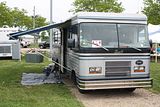Go to...  | Start A New Topic  | Search  | Notify  | Tools  | Reply To This Topic  |  |
 |
The storage barn has a good concrete floor and owner ask if I wanted to store with levelers down or up? Anyone leave yours up or down ? Please vote and vote often , like we do in Chicago. JKB | ||
|
I have heard that even the dead have been known to vote there.  | ||||
|
| The Old Man and No Barth |
IMHO, on a level concrete floor run the jacks down to level the rig, & relieve the tension on the springs & tires. If you want to go for overkill, put boards under the tires to keep 'em off the concrete. At least it won't hurt anything. Years ago I parked a car in my carport, a foreign orphan that didn't move for 2 years from lack of parts. The section of tires in contact with the concrete developed sidewall cracks while the rest of tire did not. Was it because they were flexed, or because they were in contact with the concrete? I don't know, but it happened. | |||
|
"First Year of Inception" Membership Club |
My 20 year old coach doesn't have levelers and I can't think of any negative effects attributed to that deficiency. With the exception of my wife getting up before me on a trip. My coach sits under 2 feet of snow every year on class V limestone. I have stacked some wood and carpet under the front tires and some of the big rubber mats under the rear. It is plugged in all winter, other than that and blowing out the water lines, no special handling. Looks good and starts every spring. I have had my coach 6 years ------------------   [This message has been edited by davebowers (edited October 30, 2005).] | |||
|
| First Month Member |
I'm with Roy on raising, or at least unloading the tires as much as possible. I believe sidewall bulge caused the cracking Roy mentions. I believe concrete is bad because it allows moisture to work its way into the rubber and degrade the steel belt material unless things are really dry. Vinyl mat would help prevent that. All tire manufacturers do not agree, but here is what Goodyear says: " Ideally, a vehicle in storage should be placed on blocks to remove all weight from the tires. If the vehicle cannot be put on blocks, follow these steps for tire protection: Completely unload the vehicle so that minimum weight will be placed on the tires Inflate tires to recommended operating pressure plus 25%. Ensure that the rim manufacturer’s inflation capacity is not exceeded Be sure the storage surface is firm, clean, well drained and reasonably level Avoid moving the vehicle during extremely cold weather Move the vehicle at least every three months to prevent ozone cracking in the tire bulge area, as well as “flat-spotting” from the prolonged strain of sidewall and tread deflection Adjust inflation before putting the vehicle back into service" ------------------------------------------ I would add here that if your jacks or levelers will lift the tires off the ground, there is no need to increase pressure, as the sidewalls are not flexed. | |||
|
 |
Shadow Man; They often vote more than once as needed by Da Mayor. JKB  | |||
|
| Powered by Social Strata |
| Please Wait. Your request is being processed... |
|
This website is dedicated to the Barth Custom Coach, their owners and those who admire this American made, quality crafted, motor coach.
We are committed to the history, preservation and restoration of the Barth Custom Coach.
We are committed to the history, preservation and restoration of the Barth Custom Coach.

